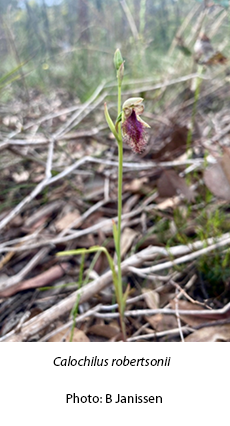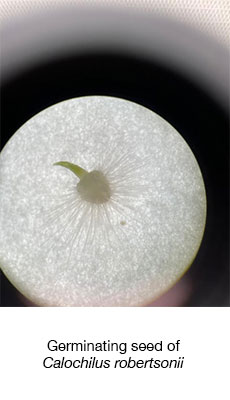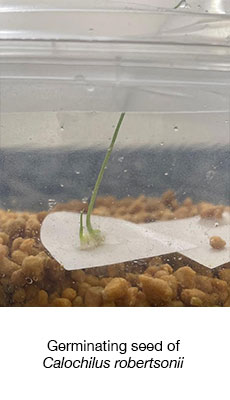<< BACK TO PROJECT LIST
Project: 342/2021
Title: Optimising in vitro germination of Calochilus (Orchidaceae)
Applicant: Brendan Janissen
Institution: Aceae Environmental, 35 Sheila Street, Preston Vic.
Calochilus is a genus of orchid with approximately 30 species spread across Australia, New Zealand, Papua New Guinea and New Caledonia. Of these 30 species, 10% are federally listed as threatened under the Environmental Protection and Biodiversity Conservation Act 1999. C. richiae is a Victorian species listed as endangered with <20 plants left in the wild. With the continued pressures of climate change (increased temperature and reduced rainfall), this species is likely to become extinct without immediate intervention. Anecdotal evidence suggests Calochilus is recalcitrant to in vitro cultivation, not surviving longer than five years after potting (Department of Sustainability and Environment 2009). Using C. robertsonii as a model species (due to available seed, plants for fungal collection, overlapping habitat and previous reports of fungal compatibility), this study aims to develop germination methods for in vitro propagation of C. richiae.


Final Report
The aim of this project was to develop symbiotic germination methods for Calochilus that could be transferrable to Calochilus richiae, which is under critical threat of extinction. Germination was tested using two base media: OMA salts only (OMA-s) and ½ Murashige and Skoog (½MS) (Murashige and Skoog 1962) and four carbon sources: oatmeal (OM), wheat bran (WB), Casuarina needles (CN) and potato (Pot). The results of this study demonstrate that OMA-s can produce later stage seedlings compared to ½ MS, which didn’t progress seedlings past stage 2. Similar greater germination percentages can be achieved using OM, CN or OMA-s alone compared to Pot and WB. OMF fungal growth was greater with Pot as a carbon source which was converse to what was observed for percent germination. It is possible that the greater ability of the OMF to utilise Pot may shift the relationship to parasitism resulting in the less germination observed. However, this trend was not consistent among all carbon sources suggesting germination differences among carbon sources may be linked to the nutrient requirements of the seed rather than the OMF requirements. Future studies should investigate the effect of OMA-s with varying concentrations of OM and CN on germination of Calochilus spp.. This research has progressed the understanding of Calochilus germination and thus the possibility of successful conservation of Calochilus richiae, when seed becomes available.

Photo: B. Janisson

Photo: B. Janisson
